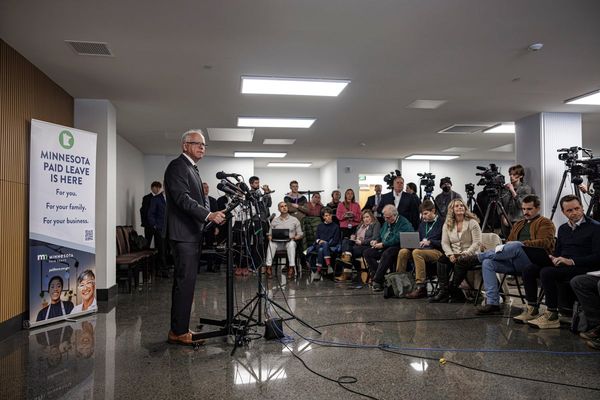
The July jobs report showed that hiring slowed markedly last month, while the unemployment rate hit a three-year high. The latest downbeat reading on the labor market could prompt the Federal Reserve to cut interest rates soon and more steeply, experts say, with at least two more reductions looking likelier before year-end.
U.S. nonfarm payrolls expanded by 114,000 last month, the Bureau of Labor Statistics said Friday, or well below economists' forecast for the creation of 175,000 jobs. Over the past year, the U.S. economy created an average of 215,000 jobs per month. Additionally, the soft June jobs report was revised lower by 27,000 jobs to 179,000.
The unemployment rate, which is derived from a separate survey, ticked up to 4.3% in July from 4.1% the prior month. The rise in unemployment triggered the Sahm Rule, a recession indicator with a perfect track record over the past 50 years.
A weakening labor market puts increasing pressure on the Federal Reserve's rate-setting group, the Federal Open Market Committee (FOMC), to lower the short-term federal funds rate at the next Fed meeting.
Fed Chief Jerome Powell opened the door to a September rate cut when the central bank wrapped up its regularly scheduled two-day policy meeting on July 31. However, after July's grim jobs numbers, market participants appear to think the Fed is behind the curve in bringing interest rates down from a 23-year high.
As of August 2, futures traders assigned an 80% probability to the FOMC enacting a half-point cut in September, up from 22% a day ago, according to CME Group's FedWatch Tool. At the same time, the odds of the Fed making a quarter-point cut at its next meeting dropped to 20% from 78% a day ago.
"July's poor employment report leaves the Fed looking woefully behind the curve with its decision to hold rates this week, and suggests that the outcome of September's meeting now is finely balanced between quarter-point and half-point easings," writes Ian Shepherdson, chairman and chief economist Pantheon Macroeconomics. "The weakness was broad-based and unattributable to one-time factors, such as the weather: the long-lagged effect of excessively tight monetary policy is to blame."
With the July jobs report now a matter of record, we turned to economists, strategists and other experts for their thoughts on what the data means for markets, macroeconomics and monetary policy going forward. Please see a selection of their commentary, sometimes edited for brevity or clarity, below.
July jobs report: The experts weigh in

"This is further proof that the economy is slowing, which has many worried the Fed is now firmly behind the eight ball. It is becoming clear that the Fed should be more worried about the economy than inflation, which is increasing the chances of a 50 basis point [half-percentage point] cut in September. Washington drama, geopolitical worries, and now we can add a slowing economy to the picture. Bad news is back to being bad news, as investors are taking a sell-first-and-ask-questions later approach right now. The big question is are we sliding right into a recession? Or is the economy simply hitting a rough spot? We'd side with we will still avoid a recession, but the risks are rising." – Ryan Detrick, chief market strategist at Carson Group
"Earlier this week, Fed Chair Powell said that the labor market was returning to a pre-pandemic state, and this job report reflects that observation. While the jobs number surprised to the downside, it is not that bad. Since 2000, the average change in nonfarm payrolls is 94,000. This reading is still better than that at 114,000. This jobs number is perhaps the first real sign that the labor market is cooling. Both the change in nonfarm payrolls and year-over-year wage growth came in weaker than expected. But this still represents healthy job growth even if below trend. We should be careful about reading too much into one employment report, but this does provide cover for the Fed to begin cutting rates in September. With unemployment jumping to 4.3%, the full employment mandate becomes more relevant." – Scott Helfstein, head of investment strategy at Global X
"After two-plus years of better-than-expected job creation, the economy printed its first major downside surprise and unemployment rose more than anticipated. This marks an official 'growth scare' and one that the Fed will have to pay close attention to. To be sure, the economy is still expanding and jobs are still being added, so calls that a recession is upon us are over-stated in our view. But the economic environment is changing quickly and the Fed should be attentive to downside risks. For investors, being balanced to risk and remaining invested in high quality stocks and bonds are the best defense as risks rise and uncertainty is likely to persist." – George Mateyo, chief investment officer at Key Wealth
"We're steady, and we're slowing: June's nonfarm payroll gains reported the slowest growth pace since January 2021, and both April and May's numbers were revised down by over fifty thousand – the clearest sign of the labor market losing momentum thus far. June's softer report on consumer spending and inflation alone was not enough to guarantee a near term rate cut, but this month's report continues to build the case. A cooling jobs report is welcome news for Fed decision makers who have been waiting for an equilibrium to emerge before confirming the probability of near-term interest rate cuts. The Fed wants consistency: more month-over-month slowdowns in wage growth and two downward revisions build the case for interest rate cuts sooner rather than later." – Eric Roberts, executive director and CEO at Fiera Capital U.S.
"The large miss in July nonfarm payrolls and jump in the unemployment rate underlines what we have been seeing in the overall U.S. economic data for some time now that aggregate demand is softening rapidly. This clearly gives the Fed the green light to start cutting rates in September, and the market's attention will now shift focus toward how many and how deep the coming cuts will be." – Scott Anderson, chief U.S. economist at BMO Capital Markets
"The July employment report showed serious cracks in the labor market, as headline hiring slowed notably during the month while the unemployment rate rose to an over two-year high. This result all but ensures an interest rate cut is in play at the Federal Reserve's next FOMC meeting in September. Markets entered the day pricing in a roughly 130% chance of a 25 basis point [quarter-point] cut in September and odds for a cut rose to 170% immediately following the release. Both short and long-term yields fell notably this morning, with the 10-year Treasury yield dropping to roughly 3.80%. Given the recent comments from Fed Chair Jerome Powell, the Fed is expected to remain data dependent when setting monetary policy in the months ahead. With that being said this release indicates that risks are rising for the labor market and more accommodative policy may be necessary to avoid a more serious slow down towards year end." – Sam Millette, senior investment strategist at Commonwealth Financial Network
"While today's jobs report was weaker than expected, we hesitate to read too much into one number, and highlight the fact that GDP growth remains relatively strong. Nearly every employment metric over the past week pointed toward a slowdown in the labor market, and this nonfarm payroll report confirms that suspicion. The market's biggest concern now is that the Fed might have waited too long to begin cutting rates and could be forced to cut rates into economic weakness. The Fed and the markets know that each additional day of restrictive policy rates means the downside risks to the economy and employment remain elevated." – Austin Schaul, head of research at Avantax
"This morning's employment report was notably weak. At 114,000 new jobs, the establishment survey showed markedly fewer jobs than expected or as seen post-pandemic. The separate household survey was also below expectations, showing an increase in both unemployed individuals and the unemployment rate. Labor force participation remained steady. This report shows continued weakening in employment and the economy overall. The Fed was already likely to cut in September but this report, if confirmed by additional weak data, could cause some to consider the possibility of a 50 basis point (1/2 percent) cut at the next meeting." – David Royal, chief financial and investment officer at Thrivent
"At first glance, the magnitude of the difference between the report of jobs added and consensus was a bit shocking. At the same time, the increase in unemployment was also bigger than expected, triggering renewed fear of recession. Overall, however, the unemployment rate is still at an average level, and we've seen a lower magnitude of monthly jobs created in the past year without triggering recession fears. The next inflation reports will be important to see if wage growth, slightly lower than expected in today's report, has kept up. And for those who believe this month's report was a signal that a recession is nigh, I would remind them that the yield curve, another powerful signal, has been inverted for a couple years. Perhaps the dislocations from the Covid crisis have rendered some reliable signals less reliable in the current economy." – Melissa Brown, managing director of investment decision research at SimCorp
"The yield curve is bull steepening, with the market now pricing in a 100% chance of a cut of at least 25 basis points in September. If inflation data comes in at or below expectations, the Fed may seriously consider a 50 basis point cut in September. It's noteworthy that 100 basis points of cuts are implied by year-end, which is aggressive given the Fed's previous communications. The rationale behind the Fed's rate cuts will shape the path forward. If cuts are due to cooling inflation, we expect a gradual decline in rates. However, this weak jobs report heightens the risk of cuts in response to labor market conditions, potentially leading to a more aggressive Fed stance." – Mike Sanders, head of fixed income at Madison Investments
"This report adds to the market's conviction that the economy has been weakening and questions if Powell made a policy mistake on Wednesday. More data will tell the full story, but for now the market sees this a big miss. One of the notable takeaways from today's report is the triggering of the Sahm rule, which reached 0.53%. This rule is a simplistic early recession indicator that compares the 3-month moving average lowest unemployment rate reached over the past 12 months to the current 3-month moving value. If this reaches 0.5% or higher, then the rule suggests the economy is in the early stages of a recession. Clearly the economy is slowing down, and the market's initial reaction has been swift." – Michael Conerly, senior fixed income portfolio manager at Exencial Wealth Advisors
"At this point, a September cut looks like a given – now the question is whether they go by 25 basis points or 50 basis points. This goes to show just how sensitive sentiment is to every data development right now, as just a week ago optimism was being buoyed by solid GDP growth and tame inflation data. The Fed may have messaged that employment and inflation risks have moved into better balance earlier this week, but it seems the scales are quickly tipping towards concerns around labor market health." – Elyse Ausenbaugh, head of investment strategy at J.P. Morgan Wealth Management
"This morning's employment reading adds to recent data of an economy slowing at an increasingly rapid pace and now puts the Fed on their heels as they appear to be behind the curve on rate cuts. Average hourly earnings came in a tenth of a percent less than expected which could be viewed as good news, but this is overwhelmed by job growth being less than expected, with downward revisions to past months, and a headline unemployment rate which moves up to 4.3%. An increase in the labor force participation rate can help explain some of the increase, but this will trigger the 'Sahm Rule' and increase the odds a recession is near. We still have economic measures which show a positive economic environment, but the basis for the Fed’s patience on rate cuts is wearing thin." – Steve Wyett, chief investment strategist at BOK Financial
"This morning's labor report all but guarantees a rate cut at the next Fed meeting. Powell pointed to increased attention toward employment earlier this week, and today's miss provides further evidence that the economy is indeed slowing, and tight conditions are having their intended impact. The question at this point is, however, will next month be a month too late for the first cut, or can this soft landing truly be engineered?" – Ben Vaske, senior investment strategist at Orion Portfolio Solutions
"These numbers reflect a sharp deceleration in hiring, confirming the weakness we saw in yesterday's claims data. The same Fed that was behind the curve on inflation could now find itself behind the curve fighting a slowdown. September 18 can't come soon enough." – David Russell, vice president of market intelligence at TradeStation







